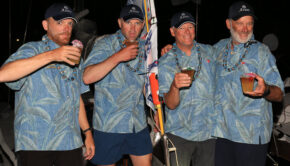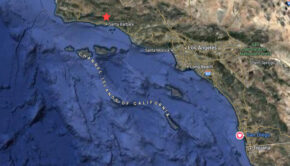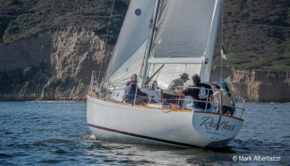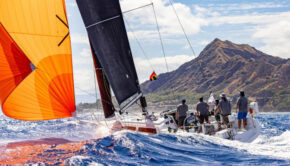First of the Flying 52s Finish Transpac
Published on July 21st, 2013
Honolulu, Hawaii (July 21, 2013) – A few years after the ULDB 70 Sled heydays of the 1980’s and 1990’s, the Transpacific YC commissioned a new class of fast offshore race boats to provide similar speeds but in smaller more modern shapes to do its signature Transpac race to Hawaii, but to also be fit for other races around the world.
The TransPac 52 was born, and ever since the this box-rule design has evolved from being designed for coastal and offshore races in California to being used as the world’s premier inshore racing class at venues in the Mediterranean and beyond. A total of sixty-six TP52’s have been built around the world over the past 12 years to plans made by the world’s best designers, making this one of the most successful design concepts in the history of offshore sailing.
Division 2 in this year’s fleet represents a unique section across a few generations of TP52 design. The latest and greatest of these started to arrive at the finish of Diamond Head today, led by Isao Mita’s Judel/Vrolijk-designed Beecom, who competed in the 52 Class SuperSeries only last year as Audi All4One. In fact, the mixed Kiwi/Japanese team on Beecom had only a few weeks to take possession of the boat, paint her blue from red, refit the boat for sailing, sail the qualifying passage in rough weather off the Farallon Islands west of the Golden Gate, and then head south to prepare for the race.
When asked how the boat held up in the race, crew member Dave “Munders” Munday summed it up in one word: “Wet. This is a MedCup boat that has a low freeboard and a lot of holes in the deck for control lines, when we were going fast the water would shoot in everywhere.”
And this is how Beecom and their seven other rival 52 teams in Division 2 sailed this race – wet and fast – as they dove south early on to stay in steady pressure at the expense of extra miles sailed on the course. Beecom led most of the way, and finished 1.5 hours ahead of a 2008-generation 52, Thomas Akins’ Reichel/Pugh-designed Meanie. In the ORR scoring used for this race, Meanie defeated Beecom in corrected time by an amazingly close 4.5 minutes. But using the High Performance Rule (HPR), making its debut here in this year’s Transpac, Beecom defeats Meanie by over 22 minutes.
Next across the finish in this division was another Reichel/Pugh design, a more modern boat from 2010 called Vincitore, owned by Ricardo Brockmann. And after that an even more modern design, Jens Kellinghusen’s Ker 51 Varuna from Germany, configured more for all-around rather than just downwind performance.
The remainder of the class is due in tonight, while the first of the ULDB Sleds makes their way in a few hours before dawn.
Others that are making their way to Oahu are Division 6 teams that comprise a different style 50-ish foot boat than the carbon-fiber, stripped out and turbo-charged TP52. This division has 9 boats that are either Santa Cruz 50’s, like Bill Helvestine’s Deception, or Santa Cruz 52’s, a more modern and comfortable cruiser/racer design like Jeff Urbina’s Bodacious IV. These teams are pushing hard to get to the finish, but are not having the easiest time with their weather to the north and east of the archipelago.
Peter Shumar, Team Deception’s navigator had this to say: “It’s a cluster out here in so many ways. Everyone in our division seems to be converging towards the finish, and to make matters more interesting, it’s scheduled to be a light-air fest and we might see some more fleet compression, getting us all closer together.
“Today’s standings were mostly good, with a bit of uh-oh. The good is that we had the 2nd highest mileage made good in our division. Roughly, it means we gained on everyone except one other boat. 2nd and 3rd place are within reach as they are only 1.5 hours away on corrected time. We also gained 4 hours on [division leader] Horizon’s corrected time, but with a 7-hour delta between us and them, they are sitting pretty – and hopefully they’ll be pretty becalmed in the Molokai Channel.
“The UH-OH is that Bodacious’ flyer is paying off. Racking up miles in the southern breeze they did an impressive 45 miles more than we did and they are only 7 minutes behind us on corrected time.
“The weather outside is frightful. We haven’t seen any sun today, but it’s been an odd mix of long squall lines, one after another interspersed between light wind and plenty of rain. We’re making good progress and have done better by this time today than we have in the past few days. That dock in Ala Wai is looking inviting right about now.”
Other finishers today include the last of the Division 7 boats starting on Monday, July 8, and the last of the Division 1 fast boats that started on Saturday, like Tom Holthus’ STP 65 Bad Pak.
Above photo of TP52 Meanie crew by David Livingston.
Yellowbrick trackers are reporting positions, speeds and headings on 6 hour delays for the rest of the fleet, which then revert to being available live as they approach within 100 miles of the finish. Online spectators can follow the racer’s progress using this system: click here to view.
And click here to see the current standings reports, and as finish times are recorded, visit www.yachtscoring.com/event_results_detail.cfm?Race_Number=1&eID=728 for latest results.
A daily video analysis on the progress of the race will be provided by race veteran and Seahorse Magazine USA editor Dobbs Davis, with guests on his show such as former Transpac winner and legendary Sled designer/builder Bill Lee. Online access to the shows are also on the race website.
Photos, videos, and other resources are also available in the Media section of www.transpacyc.com, and Facebook and Twitter will provide ongoing news, photos, videos and commentary about the activities and people involved with the 2013 Transpac.
For more information about the race, contact media@transpacrace.com or visit www.transpacyc.com.
About the Transpac: Organized by the Transpacific Yacht Club, the Transpac is a 2225-mile race from Point Fermin in Los Angeles to Diamond Head, just east of Honolulu, a distance of 2225-miles. With its first running in 1906, this is among the world’s great ocean races, and biennially attracts the world’s most talented offshore sailors and offshore sailing adventurers. For more history and information, visit www.transpacyc.com.









 We’ll keep your information safe.
We’ll keep your information safe.